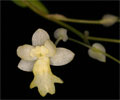|
|
|
|
|
| |
Flasks of
Lockhartia acuta 'MC4592' -spontaneous |
|
| |
|
|
| |
| Number: |
TN7199 |
| Name: |
Lockhartia acuta 'MC4592' -spontaneous
|
| Type: |
spontaneous (What's that?) |
|
Click to Enlarge

Pod Parent Flower |
Click to Enlarge

Pod Parent Leaves |
Click to Enlarge

Pod Parent Inflorescence |
Click to Enlarge

Pod Parent Blooming Plant |
|
|
|
| |
Culture Notes from Donor: Parent plant: Mounted, grown with intermediate temperatures.
Comments: Parent plant: One of the offspring from our TN3052 effort of 2002.
For additional origin/habitat information supplied courtesy of
Charles and Margaret Baker, see further below, near the bottom of this page.
|
Temperatures we attempt to use in the lab & greenhouse:
| For Species: |
|
Spring, Summer, Autumn, Winter: days average 86°F, nights 76°F; best fit is Warm 90-70°F
(Source:
Baker's Web OSC) |
|
About the name...
| Etymology of |
acuta |
|
From Latin "acutus" sharp, pointed.
(Source:
Brown 1956) |
| Etymology of |
Lockhartia |
|
Named for English botanist David Lockhart, first director of the Botanical Garden in Port Of Spain, Trinidad (Lesser Antilles) during the 19th century.
(Source:
Mayr & Schmucker 1998) |
| Pronunciation of |
acuta |
|
a-KYOO-ta
(Source:
Hawkes 1978) |
| Pronunciation of |
Lockhartia |
|
lok-HART-ee-ah
(Source:
Hawkes 1978) |
|
If you would like to direct someone to this web page, please copy and paste this URL into your email:
http://troymeyers.com/d?017199
| Ordering Information |
| You are not currently logged in. |
|
You must be a registered user and be logged in to reserve a flask or place a notification request. Please log in:
|
|
|
|
|
|
| |
The origin/habitat information below is supplied courtesy of Charles and Margaret Baker
The following information is based on the name of the plant provided by the donor, and assumes that the name is correct. If the plant has been misidentified, then the following information may not be correct.
This text is copyrighted by the Bakers and may not be reproduced without permission.
ORIGIN/HABITAT: Trinidad, Venezuela, Colombia, Costa Rica, and Panama. In
Venezuela, plants are found in the state of Aragua near Colonia Tovar; in
Barinas on the Río Paguey between La Vega and Curgatico at 1000 ft. (300
m); in the state of Carabobo; in the state of Miranda in the Parque Nac.
Guatopo at 1950 ft. (600 m); in Sucre near Cumaná; in Zulia along the Río
Negro; and in the Delta Amacuro Federal Territory. In Costa Rica, plants
grow in Puntarenas Province at 650-1300 ft. (200-400 m). In Panama, plants
occur in the lowlands near both the Pacific and Caribbean coasts, and
collections were made close to sea level in the Canal Zone near Pedro
Miguel and at 250 ft. (70-75 m) on the upper Chagres River in the Madden
Lake region. Plants grow in Panama Province near sea level, in the hills
near Panama City, in the forests of Juan Díaz near Panama City at 50-150
ft. (20-50 m), and in Chiva-Chiva near sea level. They also grow on San
José Island in the Perlas Archipelago, the island group in the Gulf of
Panama. In Colón Province, plants occur along the Río Gatuncillo near
Santa Rosa at 100 ft. (25 m) and in San Blas Province at 650-1150 ft.
(200-350 m). Specific information about the Columbian habitat was not
available, but Escobar (1991) reported that plants in this genus are
usually found at 1000-4900 ft. (300-1500 m) in semishaded, well-ventilated
areas of wet or semiwet forests.
More about this information and the Bakers...
|
|
|
| |
|
|
|